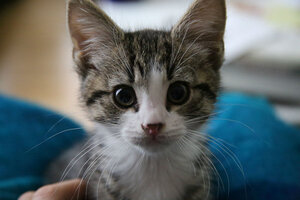Schrödinger’s cat now has a playmate
The decades-old paradox of Schrödinger’s cat, in which the feline is both dead and alive at the same time, has taken a giant leap forward. The cat now exists in two boxes, simultaneously. And it's still dead and alive.

A kitten given to WikiLeaks founder Julian Assange by his children is seen at the Ecuadorian Embassy in central London, Britain, in this undated photograph released to Reuters on May 9, 2016.
Reuters/File
Schrödinger’s cat is something many of us have heard of, but perhaps fewer actually understand.
The idea was first dreamed up by an Austrian physicist, Erwin Schrödinger, who wanted to illustrate the mind-bending nature of quantum mechanics. He created a thought experiment in this world to illustrate the point, which would allow a cat to be both dead and alive in a box at the same time.
Now, scientists have added another box. And another cat. And the first cat being dead and alive simultaneously in the first box, so this causes the second cat in the second box to also be dead and alive at the same time. Makes perfect quantum sense, right?
"It's understandable that people don't understand it," lead author Chen Wang of Yale University told The Washington Post. "You can't understand it using common sense. We can't either."
But here’s the premise: A cat sits in a box. Alongside the cat, there’s poison. That poison will only be released upon the decay of a radioactive subatomic particle.
According to quantum mechanics, and specifically the theory of “superposition,” these particles actually exist in all possible states at the same time - until, that is, someone takes a measurement. At that point, the particle falls into a single, known state.
So, the particles could be decaying, and not decaying, simultaneously. As a consequence, the poison is being released - and not released. And so the cat is both dead and alive.
Until someone opens the box, of course, and is observed. Then, the cat can't be doing both things at once.
What Dr. Wang and his team have done is to add another dimension: the concept of “entanglement.” This proposes that two objects can be intimately linked, even if billions of light-years separate them, and any change that happens to one will happen to the other instantaneously, a relationship Einstein once described as “spooky action at a distance.”
For our cat, this means, quite simply, that there’s a twin, in another box. And everything that happens to one, happens to the other.
In Wang’s experiment, there were no cats, just light. He used two aluminum cavities, each with a wave of light bouncing around inside. The researchers induced such a state so that the light existed in two different wavelengths at the same time, in both boxes.
And here we come to the key part, in terms of application: The researchers were able to take measurements without disrupting the photons, thereby retaining the dual state.
This matters because quantum mechanics holds great promise in the realm of computing. In traditional computers, the basic unit is a “bit”, which encodes either a one or a zero. But quantum bits, or “qubits”, have the ability to encode for both at the same time, allowing for vast numbers of calculations to be processed simultaneously.
The superposition of particles involved in quantum computing is, however, inherently fragile, and any disturbance to that state will mean that the data it encodes is also lost or corrupted.
"It's well understood that 99 percent of computation or more will be done to correct for errors, rather than computation itself," Wang told Live Science.
This most recent expansion of Schrödinger’s cat paradox, published Friday in Science, holds the promise of making these computational systems far more robust.

